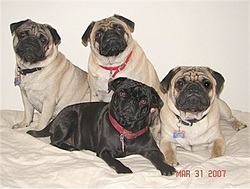
You can view any type of dogs breed with thier training method and complete description free of cost.
Cairn Terrier
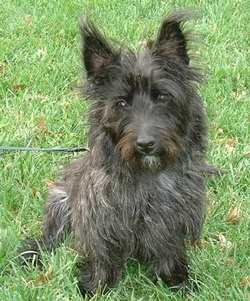
Cairn Terrier
Cairn Terrier
Description
The Cairn Terrier is a hardy little terrier, with a fox-like expression. The head is broad in proportion to the length. The strong muzzle is of medium length with a defined stop. The teeth meet in a scissors or level bite. The nose is black. The deep, wide-set eyes are hazel in color with shaggy eyebrows and topknot. The erect ears are small and set wide apart covered in short hairs. The tail is in proportion to the head with short hairs. The shaggy, double, weather-resistant coat has a harsh outer coat with a soft undercoat. The coat comes in any color accept for white, including red, brindle, blackish, sand and various shades of gray, often with dark ears, muzzle and tail tip. The final coat color of a Cairn is hard to predict as the coat changes many times for several years.
Temperament
The Cairn Terrier is an alert, animated, hardy, little dog. Loyal, curious, cheerful, lovable and friendly, they enjoy playing with children. Independent, but will listen if they see the human is stronger minded than themselves. Meek and/or passive owners will find the dog to be willful. This breed can be taught to do tricks. A fearless, bold vermin hunter, Cairns like to dig. With enough mental and physical exercise along with consistent leadership they will be calm and easy-going. Cairns adapt well to their new homes. They need firm, but not harsh, training and discipline. Without the proper leadership, the Cairn can become destructive and/or bark excessively. If they spot a rabbit or other small animal they may take off chasing it. Do not allow this little dog to develop Small Dog Syndrome, human induced behaviors, where they believe they are pack leader to humans. Cairns with this syndrome will develop all types of varying degrees of behavior problems, including, but not limited to separation anxiety, stubbornness, snapping, growling and guarding.
Height, Weight
Height: Dogs 10-13 inches (25-33 cm) Bitches 9-12 inches (23-30 cm)
Weight: Dogs 14-18 pounds (6-8 kg) Bitches 13-17 pounds (6-8 kg)
Health Problems
Often allergic to fleas. Gains weight easily.
Living Conditions
The Cairn Terrier will do okay in an apartment if it is sufficiently exercised. It is very active indoors and will do okay without a yard.
Exercise
These are active little dogs, who need a daily walk. Play will take care of a lot of their exercise needs, however, as with all breeds, play will not fulfill their primal instinct to walk. Dogs who do not get to go on daily walks are more likely to display behavior problems. They will also enjoy a good romp in a safe open area off lead, such as a large fenced in yard.
Life Expectancy
About 12-15 years.
Grooming
That shaggy "natural" looking coat actually takes quite a bit of maintenance and a neglected coat soon becomes a sorry, matted mess. Brush several times a week, being gentle with the soft undercoat. Once a month, bathe the dog and brush the coat while it dries. Trim around the eyes and ears with blunt-nosed scissors and clip the nails regularly. The Cairn sheds little to no hair.
Origin
The Cairn Terrier originated in the 1500s, in Highlands of Scotland and the Isle of Skye and is one of Scotland's original terriers. At one point it was considered the same breed as the Scottish Terrier and the West Highland White Terrier up until the 1900s when the breeds began to be bred separately. The Cairn is also said to be related to the Skye Terrier. The Cairn was named for the way it would squeeze down into "cairns" and bark at fox and badger until the farmer could arrive to kill it. "Cairns" were rock dens where badgers and fox lived, usually in piles of small stones used to mark Scottish farm borders and graves. The breed was first publicly presented in 1909 and became popular after the 1930s. It was first recognized by the AKC in 1913. It was a Cairn Terrier who played "Toto" in the Wizzard of Oz. Some of the Cairn's talents are hunting, tracking, go-to-ground trials, watchdog, agility, competitive obedience, and performing tricks.
Group
Terrier, AKC Terrier
Recognition
APRI, CKC, FCI, AKC, UKC, KCGB, CKC, ANKC, NKC, NZKC, CET, ACR, DRA, NAPR
Labrador
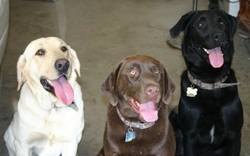
Labrador
List Your Rescue
Description
There are two types of Labradors, the English Labrador and the American Labrador. The English bred lab comes from English bred stock. Their general appearance is different. The English bred labs are heavier, thicker and blockier. The American bred Lab comes from American bred stock and is tall and lanky. The double coat is smooth and does not have any waves. Coat colors come in solid black, yellow, or chocolate. There is also said to be a rare silver or gray color that is referred to by the AKC as a shade of chocolate. This color is controversial and some claim it is a Weimaraner cross, while others say it is a true mutation. The head of the labrador is broad with a moderate stop. The nose is thick, black on black and yellow dogs and brown on chocolate dogs. The nose color often fades and is not considered a fault in the show ring. The teeth should meet in a scissors or level bite. The muzzle is fairly wide. The neck is proportionately wide and powerful. The body is slightly longer than tall. The short, hard coat is easy to care for and water-resistant. The medium sized eyes are set well apart. Eye color should be brown in yellow and black dogs and hazel or brown in chocolate dogs. Some labs can also have green or greenish yellow eyes. In silver dogs the eye color is usually gray. The eye rims are black in yellow and black dogs and brown in chocolate dogs. The ears are medium in size, hanging down and pendant in shape. The otter tail is thick at the base, gradually tapering towards the tip. It is completely covered with short hair, with no feathering. The feet are strong and compact with webbed feet which aid the dog in swimming.
Temperament
One of the most popular breeds in the USA, the Labrador Retriever is loyal, loving, affectionate and patient, making great family dogs.Highly intelligent, good-natured, very willing and eager to please, they are among the top choices for service dog work. They love to play, especially in water, never wanting to pass up the opportunity for a good swim. These lively dogs have an excellent, reliable, temperament and are friendly, superb with children and equable with other dogs. They crave human leadership and need to feel as though they are part of the family. Labs are easily trained. Some may be reserved with strangers unless very well socialized, preferably while they are still puppies. Adult Labs are very strong, train them while they are a puppy to heel on the leash, and not to bold out doorways and gateways before the humans. These dogs are watchdogs, not guard dogs, although some have been known to guard. They can become destructive if the humans are not 100% pack leader and/or if they do not receive enough mental and physical exercise, and left too much to their own devices. Show lines are generally heavier and easier going than field lines. Field lines tend to be very energetic and will easily become high strung without enough exercise. Labs bred from English lines (English Labs) are more calm and laid back than Labradors bred from American lines. English Labs mature quicker than the American type.
Height, Weight
Height: Dogs 22-24 inches (56-61cm.) Bitches 21-23 inches (53-58cm.)
Weight: Dogs 60-75 pounds (27-34kg.) Bitches 55-70 pounds (25-32kg.)
Some males can grow to 100 pounds (45kg) or more.
Health Problems
Prone to hip and elbow dysplasia, PRA and eye disorders.Living Conditions
Labrador Retrievers will do okay in an apartment if sufficiently exercised. They are moderately active indoors and will do best with at least an average-sized yard.Exercise
Labrador Retrievers are energetic dogs, delighted to work and play hard. They need to be taken on a daily, brisk, long walk, jog or run alongside you when you bicycle. While out on the walk the dog must be made to heel beside or behind the person holding the lead, as in a dog's mind the leader leads the way, and that leader needs to be the human. They will be in their glory if you give them a job to do. Gains weight easily, do not over feed.Life ExpectancyAbout 10-12 yearsGrooming
The smooth, short-haired, double coat is easy to groom. Comb and brush regularly with a firm, bristle brush, paying attention to the undercoat. Bathe or dry shampoo only when necessary. These dogs are average shedders.Origin
Once known as the "St John's Dogs," the Labrador Retriever is one of the most popular breeds in the United States. The Lab is native to Newfoundland, where it worked side by side with fishermen catching fish that came loose from the lines and trained to jump into the icy waters to help pull in the nets. Specimens were brought to England in the 1800's by English ships coming from Labrador. The breed was crossed with setters, spaniels and other types of retrievers to improve their instincts as a hunter. The Labrador is highly trainable and is not only popular as a family companion but also excels in: hunting, tracking, retrieving, watchdog, police work, narcotics detection, guide for the blind, service dog for the disabled, search and rescue, sledding, carting, agility, field trial competitor and competitive obedience.
Group
Gun Dog, AKC SportingRecognition
CKC, FCI, AKC, UKC, KCGB, CKC, ANKC, NKC, NZKC, CCR, APRI, ACR, DRA, NAPR
Bullmastif
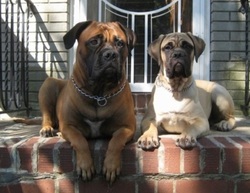
Bullmastif
Pronunciation
BullmastiffDescription
The Bullmastiff is massive, very powerfully built, but is not a cumbersome dog. The large, broad skull is wrinkled and the muzzle is broad, deep and usually darker in color. The forehead is flat and the stop is moderate. The black nose is wide and has large nostrils. The teeth meet in a level or undershot bite. The medium sized eyes are dark hazel. The V-shaped ears are set high and wide carried close to the cheeks giving a square appearance to the skull. The strong tail is set high, thicker at the root and tapering and is either straight or curved, and reaches to the hocks. The back is short, straight and level between the withers and the loin. The short, dense, slightly rough coat comes in brindle, fawn, or red, often with black markings on the head.
Temperament
The Bullmastiff is a devoted, alert guard dog, with a good-natured temperament. Docile and affectionate, but fearless if provoked. Although unlikely to attack, it will catch an intruder, knock him down and hold him. At the same time, it is tolerant of children. Intelligent, even-tempered, calm and loyal. These dogs crave human leadership. The Bullmastiff is extremely powerful and needs a firm master, who is confident and consistent with the rules set upon the dog. They should be thoroughly obedience trained, and should be taught not to pull on the leash. When going in and out gateways or doorways the dog should allow the humans to enter and exit first out of pack respect, because in the dog's mind, the leader goes first. The dog must heel beside or behind the human. This is most important as not only do dogs have migration instincts and need to walk daily, but instinct tells a dog the pack leader goes first. Be sure to socialize extensively with both people and other dogs at an early age. They can be okay withother pets, depending on how well the owners communicate with the dog. The Bullmastiff is a more dominant breed than the Mastiff. He tends to drool, slobber and snore. Puppies may seem uncoordinated. These dogs are very sensitive to the tone of your voice and need someone to speak with an air of assertiveness, but not harshly. It is not a difficult dog but does require a handler who can assert his authority. The Bullmastiff should never be banished to a kennel. Meek or passive owners will find it hard to control this dog. It will appear willful, possibly aggressive with other dogs and reserved with strangers if owners do not take the time to socialize, and know how to properly communicate what is expected in a meaningful manner.
Height, Weight
Height: Dogs 25-27 inches (63-69cm) Bitches 24-26 inches (61-66cm)
Weight: Dogs 110-133 pounds (50-60kg) Bitches 100-120 pounds (45-54kg)Health Problems
Prone to cancer, hip dysplasia, tumors, eyelid problems, PRA and boils on the lips. Alsoprone to bloat. It is a good idea to feed them two or three small meals a day instead of one large meal. Gains weight easily, do not over feed.
Living Conditions
Bullmastiffs will do okay in an apartment if it is sufficiently exercised. It is relatively inactive indoors and a small yard will do. They can not tolerate extremes of temperatures.Exercise
Bullmastiffs need to be taken on a daily walk to fulfill their primal canine instinct to migrate. Those individuals who do not get this need met are more likely to havebehavior issues. While out on the walk the dog must be made to heel beside or behind the person holding the lead, as in a dog's mind the leader leads the way, and that leader needs to be the human. Teach them to enter and exit all door and gateways after the human.Life Expectancy
Under 10 years.Litter Size
4 - 13 puppies - Average 8Grooming
The short-haired, slightly rough coat is easy to groom. Comb and brush with a firm bristle brush, and shampoo only when necessary. There is little shedding with this breed. Check the feet regularly because they carry a lot of weight, and trim the nails.Origin
The Bullmastiff was obtained by crossing 60% Mastiffs with 40% Bulldogs in the country of England. Mastiff Bulldog types can be found in records as early back as 1795. In 1924 Bullmastiffs began to be judged. Three generations of breeding of Bullmastiffs was required for Bullmastiffs to be registered as purebreds. The Bullmastiff was used as a gamekeeper's dog to track down, tackle and hold poachers. The dogs were fierce and threatening, but were trained not to bite the intruders. When the need for gamekeeper's dogs decreased, the dark brindle dogs so good for night camouflage gave way in popularity to the lighter fawn coloration. It has been prized as a hunting guard, as an aid in army and police work, and is used as a watchdog by the Diamond Society of South Africa. Today's Bullmastiff is a reliable family companion and guardian. It enjoys living with the family, with whom it comforts itself well.Group
Mastiff, AKC WorkingRecognition
CKC, FCI, AKC, KCGB, CKC, ANKC, NKC, NZKC, APRI, ACR, DRA, NAPR
List Your Rescue
Pronunciation
BulldogDescription
The English Bulldog is a wide, medium sized, compact dog, with short legs. The body and head are massive with extra skin on both the skull and forehead falling in folds. The cheeks extend to the sides of the eyes. The muzzle is wide, short and pug with a broad, deep stop. The black nose is broad with large nostrils. The dark eyes are deep set. The rose ears are small, thin and set high on the head. The jaws are massive, very broad, and square with hanging upper lips. The teeth should have an under bite. The tail is either straight or screwed and carried low. The short, flat coat is straight, smooth and glossy. Coat colors include red brindle, and other shades of brindle, solid white, solid red, fawn, fallow, piebald, pale yellow or washed-out red or white or a combination of these colors.
Temperament
Although the English Bulldogs appearance can be somewhat intimidating, it is among the gentlest of dogs. Just the same it will see off any intruder, and few would risk a close encounter with a dog brave enough to bait a bull. It is described as a very affectionate and dependable animal, gentle with children, but known for its courage and its excellent guarding abilities. Bullheaded and determined, this breed can be very persistent. They do not give up easily. Bulldogs are very much a peoples dog seeking out human attention and loving every bit it can get!! A lot of human attention is required for the breed's happiness. Some English Bulldogs can be a bit dominating and need an owner who knows how to display strong leadership and understands alpha canine behavior. A Bulldog who understands it's *place* in the human pack, is nice to, and reliable with all people. This breed is good with family pets, but some can be combative with strange dogs if they do not see themselves as followers in their pack. When Bulldogs are young, they are full of energy, but slow down as they get older. They snore very loudly, most have drool and slobber tendencies and are messy eaters. Bulldogs who display guarding, behaviors, such as guarding furniture, food, toys, or other spots in the house, or who are dog aggressive, do not have humans who are being the dogs pack leader. This behavior only happens when dogs are allowed to take over. These behaviors can be corrected when the owners start displaying the proper leadership. Dogs who feel they need to run the home are not as happy as dogs who know they are human followers, as it is very stressful for a dog to need to keep "his" humans in line.Height, Weight
Height: about 12-16 inches (31-40 cm.) (there is no prescribed height, but shorter Bulldogs are more prized when being shown)
Weight: Dogs 53-55 pounds (24-25kg.) Bitches 49-51 pounds (22-23kg.)Health Problems
Prone to breathing problems; some have small windpipes as well. Also poor eyesight, very susceptible to heat stroke in warm weather or hot rooms and cars. Very cold sensitive. Puppies often delivered by caesarian section because of their broad heads. Birth defects are common in some lines. Susceptible to skin infections, hip and knee problems. Prone to flatulence, especially when fed any other type of food other than their regular dog food.Living Conditions
The English Bulldog is good for apartment life. They are very inactive indoors and will do okay without a yard. This breed is an indoor dog. Bulldogs do best in temperate climates as the breed can chill easily in cold weather and have trouble cooling off in very hot weather.Exercise
The English Bulldog needs to be taken on a daily walk to fulfill their primal canine instinct to migrate. Those individuals who do not get this need met are more likely to have behavior issues. While out on the walk the dog must be made to heel beside or behind the person holding the lead, as in a dog's mind the leader leads the way, and that leader needs to be the human. Teach them to enter and exit all door and gateways after the human. English Bulldogs who are in good shape are capable of moving very quickly for short periods of time.
Life Expectancy
An average of 8 years. Some live longer while others live shorter lives.Litter Size
4 - 5 puppies - As a result of this breed's large head they are prone to needing a caesarian sectionGrooming
The smooth, fine, short-haired coat is easy to groom. Comb and brush with a firm bristle brush, and bathe only when necessary. Wipe the face with a damp cloth every day to clean inside the wrinkles. This breed is an average shedder.OriginThe English Bulldog originated in the British Isles, descended from the ancient Asiatic mastiff. The dog was given the name "bull" because of its use in bull baiting and for their robust look of a little bull. They were aggressive, ferocious and courageous with the power to attack full grown bulls, which they did in arena combat before the practice was banned by law in the 19th century. The bulldogs would attack from the bottom up going underneath the bull and aiming for the neck, making it hard for the bull to fight back. Today's bulldog has a very different temperament from those of his ancestors, but still retains a strong determination.
Group
Mastiff, AKC Non-SportingRecognition
CKC, FCI, AKC, UKC, KCGB, CKC, ANKC, NKC, NZKC, APRI, ACR, DRA, NAPR
English Toy spaniel
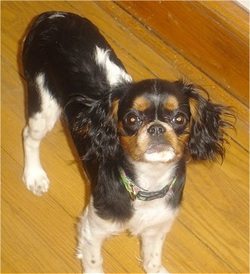
English Toy spaniel
Pronunciation
English Toy SpanielDescription
The English Toy Spaniel is a small, square shaped spaniel. The round, head is large in proportion to the dog. The muzzle is very short, with a pushed back nose and extra skin under the eyes. The stop is deep and well-defined. The black nose is large with wide nostrils. The square jaw is large and deep with a slight underbite. The large eyes are dark brown or black with black eye rims. The ears are very long, hanging close to the head with heavy feathering. The ears should not have a lot of white on them. The tail is either a natural screw, or is docked to about 2 to 4 inches (5-10 cm.) in length. Note: docking tails is illegal in most parts of Europe. The long coat is straight or slightly wavy with longer feathering on the ears, body chest, front and back legs, and feet. Coat colors come in Blenheim (white with red markings), Prince Charles (tricolor, white with black and tan markings), King Charles (black and tan), Ruby (rich mahogany red, sometimes with a few white hairs or small white patch on the chest).
Temperament
The English Toy Spaniel is gentle, happy, playful, loving and sweet. The breed is intelligent and naturally well-behaved. They will be quiet and laid back if treated gently, but firmly. They are friendly with other dogs. They will be good with all children if both owners and children are clear pack leaders towards the dog. It is an average barker, and is an okay watchdog. They are, however, considered exclusively a companion dog. Some are known to be picky eaters. The English Toy Spaniel needs to be with people who can provide them with a determined, consistent, loving approach. Do not allow this sweet dog to developed Small Dog Syndrome, human induced behaviors where the dog is led to believe they rule the home. This can cause a wide, varying degree ofbehavior issues including, but not limited to acting timid, demanding, willfulness and possible obsessive barking. If you allow things to escalate even higher they may begin to guard objects and or become untrustworthy with children and/or strange adults.
Height, Weight
Height: about 10 inches (25cm.)
Weight: 9-12 pounds (4.1-5.4kg.)Health Problems
Some bloodlines are prone to respiratory problems, heart disease (MVD), slipped stifle, eye problems and ear infections. Keep the eyes and ears clean to avoid infection. Like many other short-faced breeds, the English Toy Spaniel may wheeze and snore and have trouble breathing in hot weather if they overexert themselves, because of their very, short muzzle.Living Conditions
They are good for apartment life, relatively inactive indoors, and will do okay without a yard if they are sufficiently exercised. English Toy Spaniels do not do well in temperature extremes.Exercise
This breed needs a daily walk where the dog is made to heel beside or behind the human. Never in front, as in a dog's mind the leader leads the way, and that leader needs to be the humans and not the dog. Play will take care of a lot of their exercise needs, however, as with all breeds, play will not fulfill their primal instinct to walk. Dogs who do not get to go on daily walks are more likely to display a wide array of behavior problems. They will also enjoy a good romp in a safe open area off lead, such as a large fenced in yard. Don't think that just because he is small he should be confined to a small space.Life Expectancy
About 10-12 years.Grooming
They are average shedders. No trimming or stripping is needed. Regular brushing will due.Origin
In the late 1600's the King Charles Spaniels were interbred with Pugs, which resulted in a smaller dog with flatter noses, upturned faces, rounded heads and protruding eyes. The consequence of this breeding is what we know today as the King Charles Spaniel (English Toy Spaniel). It was developed in the British Isles and was a favorite of British Royalty. The breed was recognized by the AKC in 1886.
Group
Gun Dog, AKC ToyRecognition
CKC, FCI, AKC, KCGB, CKC, ANKC, NKC, DKCSC, NZKC, APRI, ACR, DRA, NAPR
PittBull
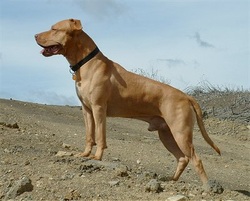
PittBull
List Your Rescue
Pronunciation
Pit Bull TerrierDescription
The Pit Bull immediately strikes one as being a dog of power, passion, and undying willingness. The brick-like head, which is especially broad between the cheeks (to house the powerful jaws), is carried upon a thickly muscled, well-defined neck. The neck runs into a deep, thick, well-sprung chest. The American Pit Bull is a very muscular, stocky, yet agile dog which is extremely strong for his size. The ears are generally cropped, though this is optional. Docked tails are not accepted by the UKC or the ADBA. The eyes are round. Both the ADBA and the UKC do not accept blue eyes or the coat color mearl. The American Pitbull Registry does accept a mearl coat. The teeth should form a scissors bite. Its coat is made up of thick, short, shiny hair. All colors are admissible. The tail tapers to a point.
Temperament
The American Pit Bull Terrier has a strong pleasure to please. The APBT has evoked more human emotional, rational, and irrational response than any other breed that exists today. By no means are these dogs people-haters or people-eaters. Their natural aggressive tendencies are toward other dogs and animals, not people. However if they are properly socialized with a firm, but calm, confident, consistent pack leader, they will not even be aggressive with them. The American Pit Bull Terrier is a good-natured, amusing, extremely loyal and affectionate family pet, which is good with children and adults. Almost always obedient, it is always eager to please its master. It is an extremely courageous and intelligent guard dog that is very full of vitality. Highly protective of his owners and the owner's property, it will fight an enemy to the death. It is usually very friendly, but has an uncanny ability to know when it needs to protect and when everything is okay. The American Pit Bull Terrier can be willful with meek owners and needs a firm hand. They are generally okay with other pets if they are raised with them from puppy hood. They are very friendly, but not recommended for most people, because most people do not understand how to properly raise and treat a dog. Problems arise when one does not understands dog psychology, seeing the dog as having human emotions, and ends up with a dog who thinks he is the boss of the house. For a smaller, not as powerful dog, people can sometimes get away with this, however, for a powerful breed, one really needs to understand and follow this concept of keeping a dog. An excellent guide to learning how to properly treat a dog is the Dog Whisperer with Cesar Millan (recommended to all dog owners regardless of the breed they own). Excellent with children in the family, they have a high pain tolerance and will happily put up with rough child play. As with any breed, they should not be left alone with unfamiliar children. Originally used as fighting dogs, the powerful American Pit Bull may go for the throat of strange dogs. A minimum of training, along with the proper amount of exercise and a firm pack leader, will produce a tranquil, obedient dog.Socialize very thoroughly when young to combat aggressive tendencies and be sure to keep the dog under control when other dogs are present. Teach this dog respect for humans by not allowing it to jump up and not allowing it to enter doorways first. The humans must make the dog heel beside or behind them when walking. It has given outstanding results as a guardian of property, but is at the same time esteemed as a companion dog. The objective in training this dog is to achieve a pack leader status. It is a natural instinct for a dog to have an order in their pack. When we humans live with dogs, we become their pack. The entire pack cooperates under a single leader. Lines are clearly defined and rules are set. You and all other humans MUST be higher up in the order than the dog. That is the only way your relationship can be a success. When properly trained and socialized, this is a very good dog and a great family companion. Unfortunately, some choose to promote the fighting instinct in the breed, giving it a bad name. If you would like to witness what a well-balanced Pitbull is like, tune into the Dog Whisperer and check out Daddy and Junior along with the rest of Cesar's pack of Pits. Daddy has since passed on, however there are still many episodes that air with him. R.I.P. Daddy.
Height, weight
Height: 18-22 inches (46-56 cm)
Weight: 22 -110 pounds (10-50 kg)Please Note: The APBT ranges in size from 22 pounds to 110 pounds (rare), with the most common being between 35 - 55 pounds (16-25 kg.), in fact the original APBT's were between 20 - 40 pounds (9-18 kg.) and were bred small for their main purpose, fighting, These dogs are varying from small to extra large. A very common misconception is that APBT's are muscle bound (viscous) hulks that weigh in around 85 pounds (39 kg.) and this is generally not the majority, Most of the APBT's that Arethat large have been crossed with another breeds.
Health Problems
A generally healthy breed, although some are prone to hip dysplasia, hereditary cataracts, allergies to grass and congenital heart disease.Living Conditions
Pits will do okay in an apartment if it is sufficiently exercised. They are very active indoors and will do alright without a yard provided they get enough exercise. Prefers warm climates.Exercise
American Pit Bull Terriers must have plenty of regular exercise and need to be taken onlong daily walks.Life Expectancy
About 12 years.Litter Size
Average of 5 - 10 puppiesGrooming
The smooth, short-haired coat is easy to groom. Brush regularly with a firm bristle brush, and bathe or dry shampoo as necessary. A rub with a piece of toweling or chamois will make the coat gleam. This breed is an average shedder.OriginDeveloped from the Bull and Terrier types of yesteryear, the American Pit Bull Terrier was originally bred as an all around farm dog, working the farms as a cattle/hog dog. Some chose to turn their talents into the sport of pit-fighting. The breed's tenacity and accompanying strength are unmatched in the canine world. As rich and captivating as the breed's history is, the Pit Bull's future is more worthy of commentary. Some proponents of the breed argue that this breed is the original bulldog of the past. Old prints and woodcarvings show reason to believe this. They show dogs that look exactly like the breed today, doing things the dog is still capable of doing. For more information on this theory you can read books by Richard F Stratton. The APBT, as registered by the UKC, is an individual breed of dog and does not refer to just any ill-bred, mindless warrior-type mongrel. At one time, the Pit Bull was a much loved, trustworthy companion. People who chose to train these dogs to fight are chiefly responsible for the banning and witch-hunting that has been sweeping the U.S. The media, however, should not go unmentioned, for it is also responsible for escalating isolated incidences in a relentless and attention-getting way. In a lot of cases when the media is reporting about a Pit Bull attacking, it is indeed not even a Pit Bull at all, but a mixed breed of some sort, or another bull breed all together. An example, there was a report on KYW news in Philadelphia about two Pit Bulls attacking a person. The dogs did not look like Pit Bulls, but rather Boxer mix looking dogs. The news station was called and asked if they knew the dogs were in fact purebred American Pit Bull Terriers, or another bull breed of some sort, or a mutt for that matter. They stated they did not know, and to call the police station to verify that information. They were asked how they could report something that they were not sure of. They had no answer and they were not sure of the dog's breed. Even after admitting on the phone that they did not in fact know the breed of the dogs in question, they kept calling the dogs Pit Bulls in their reports. Why? Because the name Pit Bull will drawl out the most attention from the public. The Pit Bull's future has been perhaps irreparably undone and everyone is to blame except the dog itself. This very loyal dog is too set on pleasing his owner, and ironically this is the root of his own undoing. Accompanying this need to please are remarkable abilities of all kinds. Jack Dempsy, Teddy Roosevelt and Jack Johnson are just a few people who have owned Pit Bulls. Pit Bulls excel in practically every canine task including herding, guarding, hunting, policing, cart pulling and ratting. A Pit Bull, named Banddog Dread, holds more canine working titles than ANY other breed. The owner's name is Diane Jessup and you can reference her book, "The Working Pit Bull." It tells you all of Dread's accomplishments. These dogs are truly capable of many tasks. The difference between Pits and American Staffordshire Terriers is a difficult one. Even breeders can't agree. The main difference is the bloodline. Amstaffs are show dogs and dog fighters won't use dogs with Amstaff blood. As time progresses there will be more of a difference. Many are duel registered as Amstaffs with the AKC and Pits with the UKC.
Group
TerrierRecognition
NAPDR, UKC, NKC, ADBA, CKC, APBR, APRI, ACR, PBFSA, DRA, BBC, NAPR
Boston Terrier

Boston Terrier
Pronunciation
Boston TerrierDescription
Boston Terriers, also called the Boston bull, are compact and well-muscled dogs. The body is short with a square appearance. The square looking head is flat on the top and in proportion to the rest of the body. The deep, wide, short muzzle is in proportion with the head. The nose is black. The stop is well defined. The bite is either even or slightly undershot giving the muzzle the square look. The large, round dark eyes are wide-set. The erect ears are small and either cropped or left natural. The limbs are straight and muscular. The legs are set somewhat wide apart, and the chest is broad. The neck is slightly arched. The low-set, tapering tail is short and either straight or screw shaped and is never docked. The short, fine textured coat comes in seal, brindle and white, black and white and some are born brown & white.
Temperament
The Boston Terrier is gentle, alert, very intelligent, well-mannered and enthusiastic. Without the proper amount of mental and physical exercise they can become rambunctious and a bit high strung. They are very sensitive to the tone of one's voice. Boston's like to learn and therefore are not difficult to train. Their intelligence ensures they pick things up quickly. If the humans around the dog do not display the leadership that all dogs need, they will become willful as they begin to believe they are running the show and need to tell YOU what to do. Do not allow the Boston Terrier to developedSmall Dog Syndrome, human induced behaviors where the dog believes he is pack leader to humans. This can cause a varying degree of behavior issues. Boston's need a gentle, but firm, confident, consistent pack leader who knows how to display authority over the dog. It is a canine instinct to have a strong leader and this little guy is no exception to the rule. Either the human will be that leader, or the dog will. Some owners have reported that their dogs are good watchdogs barking only when necessary, while other owners have reported their female Boston Terriers do not bark at the door at all. Most reliable with children, especially good with elderly people and very friendly with strangers. The Boston Terrier is playful, very affectionate and likes to be part of the family. Very popular in the United States, due above all to its excellent character. They generally get along well with non-canine pets. Without proper leadership from humans communicating to the dog what is acceptable behavior and what is not, they can become dominant and may fight with other dogs. These little dogs may be difficult tohousebreak.
Height, Weight
Height: 15-17 inches (38.1-43cm.)
Weight: 10-25 pounds (4.5-11.3kg.)Health Problems
Prone to eye problems such as juvenile cataracts, late-onset cataracts, entropion, distichiasis, glaucoma, corneal dystrophy, corneal ulcers, cherry eye, dry eyes (Keratitis Sicca) The prominent eyes are prone to injury. Also, deafness, patellar luxation, heart and skin tumors. These short-faced dogs may have breathing difficulties when stressed by exertion in hot or cold weather and can overheat if they are pushed too hard. They may also snore or drool. Whelping is often difficult as the pelvis is narrow and the large headed pups are often delivered by cesarean section.
Living Conditions
Boston Terriers are good for apartment as well as country living. They are relatively inactive indoors and do okay without a yard. This breed is sensitive to weather extremes.Exercise
A long daily walk and sessions of free play in a fenced-in yard are all the Boston Terrier needs to stay in shape. They are fairly light weight and can easily be carried.Life Expectancy
About 15 or more yearsLitter Size
Average 3 - 4 puppies - Because of this breeds large head, Caesarean births are very commonGroomingThe smooth, short-haired coat is easy to groom. Comb and brush with a firm bristle brush and bathe only when necessary. Wipe the face with a damp cloth every day and clean the prominent eyes carefully. Check both the ears and eyes for grass seeds. Ticks may also lurk in the ears. The nails should be clipped from time to time. This breed is an average shedder and does not have a strong doggie odor.OriginBred down in size from pit-fighting dogs of the bull and terrier types, the Boston Terrier originally weighed up to 44 pounds (20 kg.) (Olde Boston Bulldogge). It is difficult to believe that these stylish, little dogs were once tough pit-fighters. In fact, their weight classifications were once divided as lightweight, middle and heavyweight. Originating in the city of Boston, Massachusetts, the Boston Terrier is one of the few breeds that was developed in the USA. The original Boston Terriers were a cross between the English Bulldog and now extinct English White Terrier. Around 1865, the coachmen employed by the wealthy people of Boston began to interbreed some of the dogs owned by their employers. One of these crosses, between an English White Terrier and an English Bulldog resulted in a dog named Hooper's Judge. Judge weighed over 30 pounds (13.5 kg.). He was bred down in size with a smaller female and one of those male pups was bred to yet a smaller female. Their offspring interbred with one or more French Bulldogs, providing the foundation for the Boston Terrier. By 1889 the breed had become sufficiently popular in Boston that fanciers formed the American Bull Terrier Club, but this proposed name was not well liked by Bull Terrier lovers. Nor did they like the breeds nickname, "roundheads". Shortly after, the breed was named the Boston Terrier after its birthplace. The breed was recognized by the AKC in 1893. It was first shown in Boston in 1870. In the early years the color and markings were not very important but by the 1900's the breeds distinctive markings and color were written into the standard. Terrier only in name, the Boston Terrier has mellowed from the pit fighting dogs of the past.Group
Mastiff, AKC Non-SportingRecognition
CKC, FCI, AKC, UKC, KCGB, CKC, ANKC, NKC, NZKC, APRI, ACR, DRA, NAPR
German Shepherd
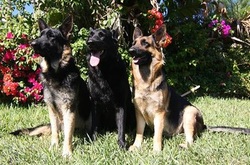
German Shepherd

